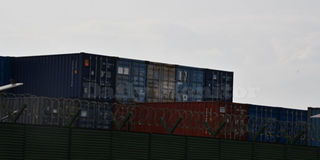Freight costs double amid shortage of containers

Shortage of containers is affecting movement of goods across the globe. PHOTO/EDGAR R BATTE
What you need to know:
- The shortage of containers, particularly in Uganda, has hit coffee exports hard with exporters resorting to bulking.
- The price of shipping a 20ft container now costs $1,500 to $2,500 while a 40ft container has doubled from $2,000 to $4,000.
Freight charges have doubled due to a global shortage of containers, prompting logistic sector players to urge port managers across East Africa to increase empty container limitations to shipping back of more containers.
Shipping agents and Container Freight Stations officials have indicated that the cost of importing a 20ft container from China to East African ports has risen from $1,500 to $2,500 while a 40ft container has doubled from $2,000 to $4,000.
Ms Merian Ssebunya, a board member of Private Sector Foundation of Uganda, who chairs the National Logistics Platform and also a freight forwarder expert, said yesterday there was a container shortage and had particularly affected coffee exports in the process.
“There has been a container shortage and particularly hitting the coffee sector,” she said.
Covid-19 has in the last two years disrupted supply chains, resulting into pile ups at different ports which has as a result created a shortage of containers.
Mr Emmanuel Iyamulemye, the Uganda Coffee Development Authority managing director, said yesterday the shortage had mostly affected small holder coffee farmers who cannot afford putting in place contingence measures.
“Yes, coffee exports have been affected. Fewer imports are coming in Uganda and the region,” he said, noting that whereas large companies, as a survival tactic, are now bulking coffee in sacks to create more empty containers, smaller exporters were struggling because they cannot afford bulking.
Last week Juma Tellah, the Kenya Ships Agents Association chief executive, accused Kenya Ports Authority and Tanzania Ports Authority of allocating limited space for empty containers, which means that very few empties were being shipped back, noting that most ports were prioritising exports, leaving empties piled up at different container depots.
“We are having empties piled up since very few containers are being returned as a result of imbalance of trade and limited space allocated for empties at the ports. There is a limited space at Mombasa and Dar es Salaam ports, which has hampered return of empties,” he said.
Mr Tellah also noted that most agents were giving priority to exports over empties since it makes more money sense over carting away empties thereby occasioning a serious container shortage in Asia.
In April a United Nations Conference on Trade and Development (UNCTAD) policy brief, noted that carriers, ports and shippers had been disrupted after empty containers were being left in places they were not needed, plus repositioning had not been planned for during the Covid-19 peak.
The UNCTAD reported that maritime trade flows increased after governments eased lockdowns and approved national stimulus packages for businesses thereby causing a container shortage.
Kenya International Freight and Warehousing Association Chairman Roy Mwanthi, said most Container Freight Stations are currently filled with empty containers as fewer ships call ports due to fewer imports.
“These past few months, few ships have docked causing an empty container pile-up,” he said.
Surging rates
In June Chinese media reported that, since April, freight rates had been surging by around five times compared to the same period in 2019.
Particularly for the European and US routes, firms are now booking containers a month in advance, the report said, noting that increasing shipping demand and short supply of shipping capacity have been driving up the prices, combined with falling turnover efficiency in overseas ports which has also aggravated the container shortage.





